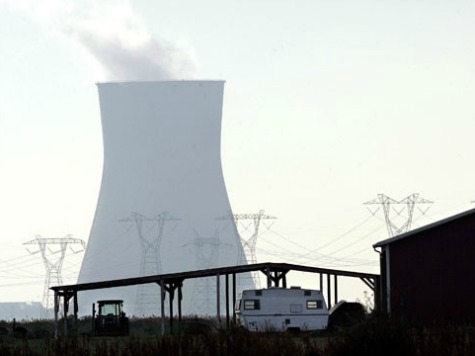By JOSH LEDERMAN
Associated Press
WASHINGTON
The nation’s oldest nuclear power plant is on alert after waters from a colossal storm reached high levels.
Oyster Creek in Lacey Township, N.J., was already offline for regular maintenance before Sandy, a superstorm downgraded Monday night from a hurricane, slammed the East Coast.
The Nuclear Regulatory Commission says an “unusual event” was declared around 7 p.m. when water reached a high level. The situation was upgraded less than two hours later to an “alert,” the second-lowest in a four-tiered warning system.
Federal officials say all nuclear plants are still in safe condition. They say water levels near Oyster Creek, which is along the Atlantic Ocean, will likely recede within a few hours.
Oyster Creek went online in 1969 and provides 9 percent of New Jersey’s electricity.
THIS IS A BREAKING NEWS UPDATE. Check back soon for further information. AP’s earlier story is below.
Federal regulators and safety officials at nuclear power plants along the Eastern Seaboard were keeping a watchful eye on wind and water levels, preparing to shut plants down should Superstorm Sandy send levels surging.
Still, by Monday evening, before the storm made landfall along the coast of New Jersey, no plants had been taken offline.
The U.S. agency that oversees nuclear safety, its own headquarters and Northeast regional office shuttered by Sandy, dispatched extra inspectors or placed them on standby in five states, equipped with satellite phones to ensure uninterrupted contact.
Nuclear power plants are built to withstand hurricanes, airplane collisions and other major disasters, but safety procedures call for plants to be shut down when hurricane-force winds are present at the site, or if water levels nearby exceed certain flood limits.
At the Salem and Hope Creek plants in Hancocks Bridge, N.J., which together produce enough power for about 3 million homes per day, officials were watching for sustained winds of 74 mph or greater that would trigger taking the plants offline. The nearby Delaware River posed another hazard if water levels exceed 99.5 feet, compared with a normal level of 89 feet.
Joe Delmar, a spokesman for Public Service Enterprise Group Inc., said that only essential employees had been asked to report to work but that current projections were that the plants would not have to close.
One of the units at Salem had already been offline due to regular refueling and maintenance. That was also the case at Oyster Creek, a 636-megawatt plant in Lacey Township, N.J., roughly 60 miles east of Philadelphia.
In Lusby, Md., the Calvert Cliffs Nuclear Power Plant was operating at full power _ enough to power more than 1 million homes. Additional staff, both onsite and off, were called in to prepare for the storm. Safety officials there will take the plant offline if sustained winds exceed 75 mph or water levels rise more than 10 feet above normal sea level.
Seventy-five was also the number at Indian Point in Buchanan, N.Y., where officials said they were fully prepared to withstand surging water levels from the Hudson River. At Pennsylvania’s Susquehanna plant in Salem Township, officials were ready to activate their emergency plan, a precursor to taking the plant offline, if sustained winds hit 80 mph.
At the Millstone nuclear power complex on Connecticut’s shoreline, officials said they were powering down one of the two reactors to 75 percent of maximum output to maintain stability of the electric grid. Millstone spokesman Ken Holt said the grid’s stability could be affected if the unit was operating at 100 percent and suddenly went offline, which isn’t expected to happen.
Some 60 million people in 13 states plus the District of Columbia get their power from PJM, the largest regional power grid in the U.S. Contingency plans call for power to be brought in from other areas to replace power lost if a nuclear plant reduces output or goes offline.
In August 2011, multiple nuclear plants shut down due to Hurricane Irene, with others reducing power.
Although nuclear plants are built for resilience, their operations get more complicated when only emergency personnel are on duty or if external electricity gets knocked out, as often happens during hurricanes.
___
Reach Josh Lederman on Twitter at http://twitter.com/joshledermanAP

COMMENTS
Please let us know if you're having issues with commenting.